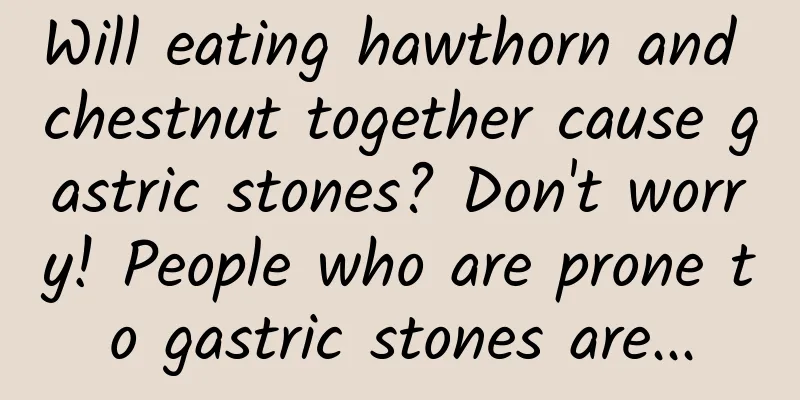Will eating hawthorn and chestnut together cause gastric stones? Don't worry! People who are prone to gastric stones are...

|
gossip Recently, hawthorns and chestnuts are available in supermarkets. As seasonal delicacies, many people buy them to eat. However, a piece of news #doctor reminds that hawthorn and chestnut should not be eaten together # has recently become a hot topic. It turns out that a netizen was diagnosed with gastritis and gastric stones after eating hawthorn and chestnut together. So, does eating hawthorn and chestnut together really cause gastric stones? Can we still eat hawthorn and chestnut with confidence? Image source: Screenshot of our Su special report on Weibo analyze What is gastrolith? Gastric bezoar, also known as gastric stones or gastric stone disease, is a lumpy substance formed by the retention of indigestible substances in the stomach. These substances can neither be digested nor pass through the pylorus smoothly, so they stay in the stomach for a longer time and gradually form stones under the action of gastric acid. Patients with gastric stones may experience abdominal discomfort, which affects their normal eating. The friction of the stones may also cause damage to the gastric mucosa, leading to gastric ulcers. A few may even cause upper gastrointestinal bleeding due to ulcers. In rare cases, stone incarceration may lead to small intestinal obstruction, intestinal wall necrosis, and perforation. Therefore, if you have gastric stones, you must treat them as soon as possible. Copyrighted stock images, no reproduction is authorized According to the composition of gastric stones, they can be roughly divided into four categories: plant stones, hair stones, drug stones and mixed stones . ① Plant-based gastric stones: This is the most common type of gastric stone, mainly composed of various undigested plant components, including tannic acid, cellulose, pectin, gelatin, etc. Among them, persimmon stones (including persimmon cakes) and hawthorn stones are the most common plant-based stones. ② Hair stones: composed of hair, and may also be mixed with wool yarn and animal hair, etc., and are more common in people who have the habit of swallowing hair. ③ Drug-induced gastric stones: formed by long-term use of inorganic chemical drugs containing calcium, bismuth, etc. or antacids (such as aluminum hydroxide gel, calcium phosphate), etc. These drugs can precipitate in the stomach, or form small clumps under the action of gastric acid and aggregate with food residues to form gastric stones. ④Mixed gastric stones: gastric stones formed by a mixture of multiple components. In what situations are you more likely to get gastric stones? The formation of gastric stones requires two basic conditions: indigestible substances and increased contact with the stomach. Anyone who is prone to these conditions is prone to gastric stones. According to the current epidemiological survey and analysis of patients with gastric stones, gastric stones are prone to occur in the elderly, diabetic patients, and people with previous gastric diseases such as peptic ulcers. People with poor gastric function: The formation of gastric stones in adults is related to the complex changes in the gastric environment. Peptic ulcer, chronic gastritis, Crohn's disease, tumors, gastrointestinal dehydration, etc. are all high-risk factors for gastric stones. Diabetic patients: The stomach emptying of diabetic patients is usually slower and they are relatively prone to forming gastric stones. Elderly people: Especially emphasize that the elderly have reduced gastrointestinal function, more cardiovascular, endocrine, and nervous system diseases, and more abdominal surgeries than young people, which makes them more likely to develop gastric stones. In addition, for children, accidentally swallowing foreign objects, pica, intellectual disabilities, mental illness, and celiac disease can also cause gastric stones. In general, people with poor stomach function (such as those after gastric surgery, gastritis, gastric ulcer, etc.) may develop gastric stones if they eat food that is difficult to digest. Will eating hawthorn and chestnut together cause gastric stones? It is said in the hot search that hawthorn and chestnut cannot be eaten together. Hawthorn contains tannic acid, and chestnut contains a lot of dietary fiber and starch, which can cause gastric stones. In fact, this just reverses cause and effect. Copyrighted stock images, no reproduction is authorized Some hawthorns do contain a lot of tannic acid, and chestnuts do contain a lot of dietary fiber. Under the action of gastric acid, tannic acid combines with protein to form a water-insoluble precipitate. At the same time, the pectin and gum in them can also coagulate when exposed to acid, and glue the peel, fiber and food residues together to form clots, and then form gastric stones. But for normal people, eating this way will not cause any problems. Only those with poor gastrointestinal function will form gastric stones. For example, people with digestive tract diseases such as gastric ulcers and gastritis are prone to acid reflux. If they eat these foods, a large amount of tannic acid, gelatin, dietary fiber and other substances will react chemically with gastric acid to generate water-insoluble precipitates, which slowly form lumps and become gastric stones. In addition, not all hawthorns have a lot of tannic acid. In fact, the tannic acid content of hawthorns that have been de-astringent and sold regularly is generally very low. Otherwise, no one would buy them to eat. Because tannic acid has a characteristic that if the tannic acid content is high, the taste will be particularly astringent and unpalatable. There is another detail that many people have overlooked. If you look closely at his medical records, you can see that he had superficial gastritis detected by gastroscopy a year ago, and the actual medical history may be longer. It just so happened that he had recently eaten a lot of hawthorn and chestnuts, which led to the formation of gastric stones. The netizen had superficial gastritis when he had a gastroscopy last year, and the actual history of the disease may be longer. Image source: Screenshot of Wosu’s special report on Weibo In fact, there is no special taboo about eating hawthorn and chestnut together. There is currently no evidence that eating hawthorn will directly cause gastric stones in normal (healthy) people. Can I still eat hawthorn and chestnut? Copyrighted stock images, no reproduction is authorized Gastric stones are a rare disease with a low overall incidence rate. The probability of gastric stones being caused by eating hawthorn and chestnuts is even lower. Therefore, you don’t need to worry too much. We recommend that you: ▶ 1. Hawthorn does contain tannic acid, pectin and other substances. The characteristic of tannic acid is that it tastes very astringent and not delicious. If you happen to eat hawthorn that is very astringent and not delicious, then don't eat it. Also, don't buy or eat some roadside or wild hawthorns at will, as they may contain more tannic acid. ▶ 2. The tannic acid content in mature hawthorns sold in regular supermarkets and online stores is generally very low. After all, hawthorns with too much tannic acid are unpalatable and no one buys them. For normal people, as long as you do not feel uncomfortable or unwell after eating them, you can eat them with confidence. ▶ 3. Eat in moderation. Although hawthorn and chestnut are delicious, it is recommended that you keep in mind the principle of moderation when eating at any time. According to the recommendations of the Food Pagoda, do not eat too much, let alone eat a lot every day. Even for healthy people, eating too much in a short period of time will increase the digestive burden of the gastrointestinal tract, and the function of the gastrointestinal tract will be damaged in the long run, thereby increasing the risk of gastrointestinal diseases such as gastric stones. ▶ 4. People with excessive gastric acid secretion and poor gastric motility, or people suffering from gastric diseases such as gastritis and gastric ulcer, or people who have recently undergone gastric surgery, should try not to eat fruits with high tannic acid content such as hawthorn and foods with high dietary fiber such as chestnuts, especially hawthorns that are too astringent and unripe, and do not eat them on an empty stomach. ▶ 5. If you often feel stomach discomfort after eating hawthorn and chestnut, try not to eat them. This also means that there may be problems with your stomach function. It is best to take time to go to the hospital for a check-up to find out the problem and avoid worsening of the condition. in conclusion There is no sufficient evidence to show that eating hawthorn or mixing hawthorn and chestnut will directly cause gastric stones in healthy people, so there is no need to worry too much. Friends who like to eat hawthorn and chestnut can eat them without worry, but pay attention to controlling the amount and not eating a large amount at one time. Author: Ruan Guangfeng, Deputy Director of the Science and Technology Information Exchange Center for Food and Health Audit: Zhong Kai, Researcher at the National Food Safety Risk Assessment Center Sun Yifei Director of the Medical Education History Research Office, Hebei Medical University References: Iwamuro M, Okada H, Matsueda K, Inaba T, Kusumoto C, Imagawa A, Yamamoto K. Review of the diagnosis and management of gastrointestinal bezoars. World J Gastrointest Endosc. 2015 Apr 16;7(4):336-45. doi: 10.4253/wjge.v7.i4.336. PMID: 25901212; PMCID: PMC4400622. Zhang Yang, Lü Yiguang. Etiology, diagnosis and treatment progress of gastric lithiasis[J]. Modern Medicine, 2020, 48 (07): 925-930. Liu Yaping, Wang Dong, Li Zhaoshen. Clinical progress in the treatment of gastric stones[J]. Chinese Journal of Endoscopy, 2016, 22 (11): 79-82. Jin Shilu, Xu Yanping. Types and progress in diagnosis and treatment of gastric lithiasis[J]. Chinese Journal of Clinical Physicians (Electronic Edition), 2012, 6 (01): 153-155. Duan Changnong, Xu Gang. Advances in the treatment of gastric stones in China[J]. Journal of Gastroenterology and Hepatology, 2011, 20 (08): 778-781. Yin Feilong, Zheng Dadian, Liu Yu, et al. Effects of different astringency removal treatments on postharvest storage quality of Zhongtian hawthorn[J]. Science and Technology of Food Industry, 2021, 42(17): 316-325. DOI: 10.13386/j.issn1002-0306.2020110182. http://hnxbl.cnjournals.net/html/hznydxzr/2021/2/20210224.html https://www.ncbi.nlm.nih.gov/pmc/articles/PMC7549533/ https://www.ncbi.nlm.nih.gov/pmc/articles/PMC8101514/ Planning丨Lin Lin Editor: Zhong Yanping Layout|Li Mengxin The article is produced by "Science Refutes Facts" (ID: Science_Facts). Please indicate the source when reprinting. The cover image and images within this article are from the copyright gallery. Reprinting and quoting them may lead to copyright disputes. |
<<: In addition to sour, sweet, bitter, salty and umami, there may be a sixth basic taste!
Recommend
The photos taken by the Hubble telescope are actually black and white, but NASA used PS to turn them into color...
In the Cat's Eye Nebula three thousand light-...
The most comprehensive | 108 ways to promote products, come and try
1. SNS online store soft article promotion method...
China Passenger Car Association: Light Commercial Vehicle Market Forecast Research Report in September 2022
1. Industry Insights Auman's new million-car ...
Is it Tianshui's turn this time? Gansu Malatang has a huge "traffic" explosion, what makes it so delicious?
Author: Fluent As if overnight, "Gansu Malat...
How does an operator plan an event? (Mind Map)
In Internet companies, operations is a common job...
This is the real value of the mini program, but it will never replace the App
WeChat Mini Programs have been launched for some ...
Quick Look! An Illustrated Guide to Marine Life in the Paleozoic Era 600 Million Years Ago (Part 2)
In the last issue, I introduced two arthropods, L...
Pop Mart goes public, taking stock of the top 5 blind box marketing strategies!
On December 11, 2020, Pop Mart (09992.HK) was lis...
8 years of Double 11: What else can we see besides pessimism and doubt?
120.7 billion, a year-on-year increase of 32.3%. ...
How to place ads on Kuaishou? HOW DOES IT PERFORM?
Kuaishou is one of the few short video communitie...
Qualcomm test proves: Yes, drones can be controlled with 4G signals
The drone craze has swept the world. Although the...
Hprose for Node.js 1.6.0 released
Hprose is an advanced lightweight cross-language ...
In the winter, I am going to be "numbed by static electricity"! Is there anyone who can control static electricity?
When the weather gets cold Many people have added...
Is the fruit and vegetable cleaning machine with monthly sales of over 2,000 worth buying? Test 3 models and tell you the answer
Pesticide residues have always been a concern for...









